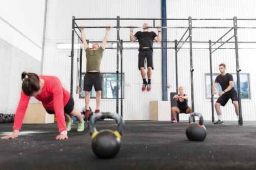All About CrossFit – A Beginner’s Guide
Wednesday, August 31, 2016 - 09:00

In the last decade, CrossFit has become immensely popular across the world with over 12,000 locations and the introduction of the CrossFit Games in 2007. Originally created by American Greg Glassman, CrossFit is a training philosophy centred on functional fitness movements. Functional fitness are types of exercises that are designed to mimic activities or movements that one would encounter in everyday life, such as running, rowing, weightlifting, and gymnastics. These activities are performed at a very high intensity level with short workouts typically lasting about 30 minutes.
Do you have to be fit to start?
The short answer is no, unless there a pre-existing injury or health issue, anyone can try it. As with any new workout, it’s recommended to start slow and be sure to get training from a certified trainer on the proper technique for each movement.
Pros:
It’s challenging with big expectations - No matter your fitness level, the CrossFit workouts are designed to be challenging, gym goers are encouraged to push boundaries, exceed their physical limits, and set lofty goals. High-intensity interval training (HIIT) is an essential part of the CrossFit exercise programming. It’s been shown to be an effective and efficient way to increase cardiovascular endurance and build muscle strength.
Strong community - CrossFit encourages people of all shapes and sizes to improve their physical and mental well-being in a hardcore yet accepting and encouraging environment. The grueling nature of the timed workouts of the day (WOD) are performed in a group setting with measured results of each person’s workout posted at the end of each class posted for all to see. The culture of positivity and hard work toward a common goal is a very powerful motivator for improvement.
Offers competition - In the CrossFit Games, athletes compete in eight different events over the course of three days, the Games are different every year and test the limits of strength, endurance, and mental fortitude. Part of the appeal of the Games is that anyone can train to compete. Despite small beginnings, the Games are now a large sponsored event with millions of viewers tuning in around the world to see which male and female will carry the title ‘fittest person on earth.’
Cons:
Lack of quality trainers - Critics have claimed that the standards for becoming a certified CrossFit trainer are too easy. While a trainer can work up to 4 different levels of coaching, the Level 1 certification can be obtained by attending a weekend course and passing 50 question written test. With this certification, participants have the opportunity to coach others in affiliate gyms or ‘boxes’ in CrossFit terminology.
Higher risk of injury - Some of the controversy that surrounds CrossFit is the seemingly higher risk of injury. Part of the issue stems from the fact that each training session is designed as a group workout with beginner exercisers in the same room as the advanced group. The physically demanding, fast-paced environment combined with inexperienced exercisers (and/or trainers) can easily result in major injuries.
The popularity and rapid growth of CrossFit can be attributed the engaging community atmosphere, the growing stature of the CrossFit Games and a seemingly endless variety of tough, short workouts that see fast results. As with any new exercise trend, there are benefits and risks, and it’s ultimately up to each individual to decide if they are up to the CrossFit challenge.
References:
ALL ABOUT CROSSFIT. Muscle & Fitness Hers. July 2016;17(4):30.
Bellar D, Hatchett A, Judge L, Breaux M, Marcus L. The relationship of aerobic capacity, anaerobic peak power and experience to performance in CrossFit exercise. Biology Of Sport. October 2015;32(4):315-320.
Butcher S, Judd T, Benko C, Horvey K, Pshyk A. RELATIVE INTENSITY OF TWO TYPES OF CROSSFIT EXERCISE: ACUTE CIRCUIT AND HIGH-INTENSITY INTERVAL EXERCISE. Journal Of Fitness Research. August 2015;4(2):3-15.
Köteles F, Kollsete M, Kollsete H. PSYCHOLOGICAL CONCOMITANTS OF CROSSFIT TRAINING: DOES MORE EXERCISE REALLY MAKE YOUR EVERYDAY PSYCHOLOGICAL FUNCTIONING BETTER?. Kinesiology. June 2016;48(1):39-48.
Mullins N. CrossFit: Remember What You Have Learned; Apply What You Know. Journal Of Exercise Physiology Online. December 2015;18(6):32-44.
About the Author: Michelle is an information management specialist with many years focusing on sport and fitness research and education. Michelle has been sharing her expertise with SIRC for over 3 years.